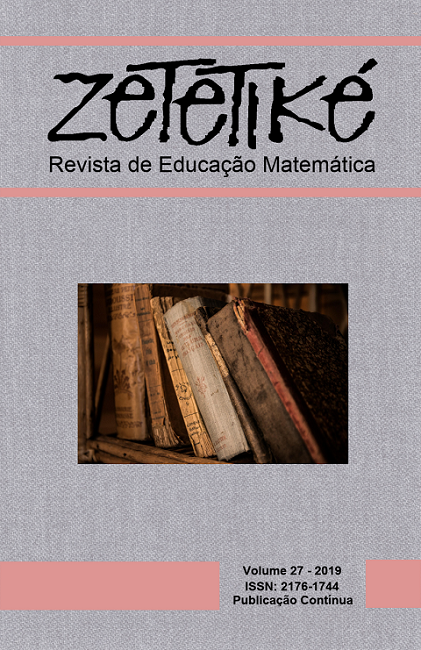Abstract
In this paper we analyse two 3rd grade teacher’s practices, Carla and Ricardo, in order to understand the characteristics of their actions, specifically how they explore a task in the classroom, how they question their students and which are the representations that they privilege. Data were collected through participant observation, supported by audio and video recording and were analysed through content analysis. The results suggest that the action of informing appears more often and is frequently combined with rhetorical focusing questions and/or closed confirmation questions. Likewise, challenging actions, that are less common, appear relate with to inquiry questions. In order to promote the use of representations by their pupils, both teachers adapt their actions and the questioning that they use so they can promote: (i) the use and transformation of a chosen representation; and (ii) pupils’ critical thinking about the main aspects of the task
References
Acevedo Nistal, A., Dooren, W. V., Clarebout, G., Elen, J., & Verschaffel, L. (2009). Conceptualizing, investigating and stimulating representational flexibility in mathematical problem solving and learning. ZDM Mathematics Education, 41(5), 627–636.
Bardin, L. (1977). Análise de conteúdo. Lisboa: Edições 70.
Boaler, J., & Brodie, K. (2004). The importance of depth and breadth in the analyses of teaching: A framework for analyzing teacher questions. Proceedings of the 26th Meeting of the North American Chapter of the International Group for the Psychology of Mathematics Education. Toronto, Ontario, Canada.
Bishop, A., & Goffree, F. (1986). Classroom organization and dynamics. In B. Christiansen, A. G. Howson & M. Otte (Eds.), Perspectives on mathematics education (pp. 309-365). Dordrecht: D. Reidel.
Blosser, P.E. (1975). How to ask the right questions. Washington DC: National Science Teachers Association.
Bruner, J. (1999). Para uma teoria da educação. Lisboa: Relógio d’Água.
Duval, R. (2006). A cognitive analysis of problems of comprehension in a learning of mathematics. Educational Studies in Mathematics, 61, 103–131.
Goldin, G. (2000). Representational systems, learning, and problem solving in mathematics. Journal of Mathematical Behavior, 17(2), 137-165.
Goldin, G. (2008). Perspectives on representation in mathematical learning and problem solving. In L. English (Ed.), Handbook of international research in mathematics education (pp. 178-203). New York, NY: Routledge.
Laville, C., & Dionne, J. (1999). A construção do saber: Manual de metodologia da pesquisa em ciências humanas. Porto Alegre: Artes Médicas.
Mason, J. (2000). Asking mathematical questions mathematically. International Journal of Mathematical Education in Science and Technology, 31(1), 97-111.
McClain, K. (2000). An analysis of the teachers’ role in supporting the emergence of symbolizations in one first-grade classroom. Journal of Mathematical Behavior, 19, 189-207.
Merriam, S. B. (1988). Case study research in education: A qualitative approach. CA; Jossey Bass.
Moyer, P. S., & Milewicz E. (2002). Learning to question: categories of questioning used by preservice teachers during diagnostic mathematics interviews. Journal of Mathematics Teacher Education, 5, 293-315.
NCTM (2000). Principles and standards for school mathematics. Reston, VA: NCTM.
Ponte, J. P. (2005). Gestão curricular em Matemática. In GTI (Ed.). O professor e o desenvolvimento curricular (pp. 11-34). Lisboa: APM.
Ponte, J.P., Mata-Pereira, J., & Quaresma, M. (2013). Ações do professor na condução de discussões matemáticas. Quadrante, 22(2), 55-82.
Ponte, J. P., & Serrazina, M. L. (2000). Didáctica da Matemática, 1.º ciclo. Lisboa: Universidade Aberta.
Purdum-Cassidy, B., Nesmith, S., Meyer, R. D., & Cooper, S. (2015). What are they asking? An analysis of the questions planned by prospective teachers when integrating literature in mathematics. Journal of Mathematics Teacher Education, 18, 79-99.
Stylianou, D. A. (2010). Teachers’ conceptions of representation in middle school mathematics. Journal of Mathematics Teacher Education, 13, 325-343.
Swan, M. (2007). The impact of task based professional development on teachers’ practices and beliefs: A design research study. Journal of Mathematics Teacher Education, 10, 217-237.
Thomas, N. D., Mulliganb, J. T., & Goldin, G. A. (2002). Children’s representation and structural development of the counting sequence 1–100. Journal of Mathematical Behavior, 21(1), 117-133.
Tripathi, P. N. (2008). Developing mathematical understanding through multiple representations. Mathematics Teaching in the Middle School, 13(8), 438-445.

This work is licensed under a Creative Commons Attribution-NonCommercial-NoDerivatives 4.0 International License.
Copyright (c) 2019 Zetetike


